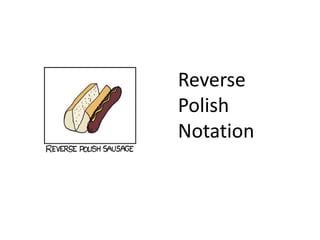Reverse polish notation
•Transferir como PPTX, PDF•
0 gostou•2,752 visualizações
Denunciar
Compartilhar
Denunciar
Compartilhar

Recomendados
Recomendados
DATA STRUCTURES AND ALGORITHMS UNIT-3 TREES PREPARED BY M V BRAHMANANDA REDDY

DATA STRUCTURES AND ALGORITHMS UNIT-3 TREES PREPARED BY M V BRAHMANANDA REDDYMalikireddy Bramhananda Reddy
Mais conteúdo relacionado
Mais procurados
DATA STRUCTURES AND ALGORITHMS UNIT-3 TREES PREPARED BY M V BRAHMANANDA REDDY

DATA STRUCTURES AND ALGORITHMS UNIT-3 TREES PREPARED BY M V BRAHMANANDA REDDYMalikireddy Bramhananda Reddy
Mais procurados (20)
DATA STRUCTURES AND ALGORITHMS UNIT-3 TREES PREPARED BY M V BRAHMANANDA REDDY

DATA STRUCTURES AND ALGORITHMS UNIT-3 TREES PREPARED BY M V BRAHMANANDA REDDY
Polynomial reppresentation using Linkedlist-Application of LL.pptx

Polynomial reppresentation using Linkedlist-Application of LL.pptx
Mais de grahamwell
Mais de grahamwell (20)
Reverse polish notation
- 3. 6,2/1,2+* * / + 6 2 1 2 / 6,2,1,2,+*/ * + 6 2 1 2
- 4. Evaluating RPN • Uses a stack and two simple rules. Reading left to right ……. • 1. If a value appears next in the expression, push this value on to the stack. • 2. If an operator appears next, pop two items from the top of the stack and push the result of the operation on to the stack.
- 5. Reverse Polish Notation Examples 7,4+3- 7+4-3 1,2*3+ 1*2+3 1,2+3* (1+2) *3 5,9,2*+ 5+9*2 1,2*3,4*+ 1*2+3*4
- 6. Converting from infix to postfix ‘Shunting yard algorithm’ • Read each character • Calculator - another • If its an operand, add it to the output • If it’s an operator then – If there’s a higher BODMAS priority operator at the top of the stack, pop it – Push it on the stack • At the end, pop everything off the operator stack